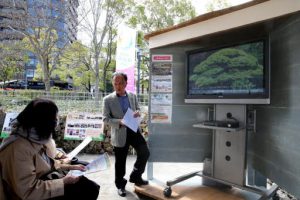Video shown at main venue of flower fair Hiroshima Hananowa 2020 features bonsai peace tree
Mar. 25, 2020
by Kyoko Niiyama, Staff Writer
A video of a bonsai tree exposed to the Hiroshima atomic bombing and presented to the United States 45 years ago is currently being shown at the main site of the National Urban Green Fair in Hiroshima (Hiroshima Hananowa 2020), in the city’s Naka Ward, on the site of the former Hiroshima Municipal Baseball Stadium. The civic group that produced the video indicated, “We’d like visitors to the event to know about this bonsai, which silently calls for peace from the United States.”
The video, titled “Goyomatsu (Japanese white pine)—A-bombed bonsai tree sent from Hiroshima,” shows images of the roughly 400-year-old Miyajima pine tree, cultivated by the late bonsai artist Masaru Yamaki, at the time the tree was exposed to the atomic bombing about 2.5 kilometers from the hypocenter. It also explains the background behind presentation of the A-bombed bonsai tree to the United Sates in 1975, one year before the year marking the 200th anniversary of the founding of the United States, as well as the current appearance of the tree at the U.S. National Arboretum, in the U.S. capital of Washington, D.C.
The video, provided with English subtitles, is 22 minutes in length. It is a newly revised version of a video originally produced in 2018 by the Shizumi Peace Project. Project members include Shizumi Shigeto Manale, 71, who was born in the city of Miyoshi, Hiroshima Prefecture and now resides in the United States. The video will be shown occasionally in the event’s multi-purpose tent through May 24.
The Shizumi Peace Project also produced a video featuring a story about post-war communication between Honkawa Elementary School, which is located in Naka Ward and was damaged in the atomic bombing, and a church in the United States that sent relief supplies to the school. “The bonsai video will serve as an opportunity for Hiroshima citizens to be aware of the bridge of peace that connects Japan and the United States,” said project member Toshikuni Sera, 73, a resident of Hatsukaichi City.
(Originally published on March 25, 2020)
Bonsai exposed to atomic bombing 2.5 km from hypocenter presented to U.S. in 1975
A video of a bonsai tree exposed to the Hiroshima atomic bombing and presented to the United States 45 years ago is currently being shown at the main site of the National Urban Green Fair in Hiroshima (Hiroshima Hananowa 2020), in the city’s Naka Ward, on the site of the former Hiroshima Municipal Baseball Stadium. The civic group that produced the video indicated, “We’d like visitors to the event to know about this bonsai, which silently calls for peace from the United States.”
The video, titled “Goyomatsu (Japanese white pine)—A-bombed bonsai tree sent from Hiroshima,” shows images of the roughly 400-year-old Miyajima pine tree, cultivated by the late bonsai artist Masaru Yamaki, at the time the tree was exposed to the atomic bombing about 2.5 kilometers from the hypocenter. It also explains the background behind presentation of the A-bombed bonsai tree to the United Sates in 1975, one year before the year marking the 200th anniversary of the founding of the United States, as well as the current appearance of the tree at the U.S. National Arboretum, in the U.S. capital of Washington, D.C.
The video, provided with English subtitles, is 22 minutes in length. It is a newly revised version of a video originally produced in 2018 by the Shizumi Peace Project. Project members include Shizumi Shigeto Manale, 71, who was born in the city of Miyoshi, Hiroshima Prefecture and now resides in the United States. The video will be shown occasionally in the event’s multi-purpose tent through May 24.
The Shizumi Peace Project also produced a video featuring a story about post-war communication between Honkawa Elementary School, which is located in Naka Ward and was damaged in the atomic bombing, and a church in the United States that sent relief supplies to the school. “The bonsai video will serve as an opportunity for Hiroshima citizens to be aware of the bridge of peace that connects Japan and the United States,” said project member Toshikuni Sera, 73, a resident of Hatsukaichi City.
(Originally published on March 25, 2020)








